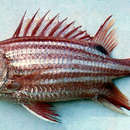Diagnostic Description
provided by Fishbase
Body with subequal stripes of brownish red and silvery white; spinous dorsal dark red with a large, quadrangular, whitish blotch in middle of each membrane (except the first) forming a median band; dorsal membrane tips white, except posteriorly (Ref. 4201). Five oblique scale rows on cheek; body depth 2.5-2.8 in SL; head length (HL) 2.65-2.85 in SL; short and blunt snout, its length 4.25-4.7 in HL; interorbital width 4.5 in HL; mouth terminal to slightly inferior, maxilla usually extending nearly to or a short distance beyond a vertical through center of eye, upper jaw length 2.5-2.75 in HL; premaxillary groove often ending above anterior edge of orbit; anterior end of nasal bone with a blunt spine; surface or medial edge of nasal bone spineless; nasal fossa usually without spinules on its edge; upper edge of 1st suborbital bone with a slightly retrorse lateral spine a short distance posterior to a vertical at front edge of eye, followed by a ridge of recumbent spinules; preopercular spine usually about 2/3 orbit diameter, 3.2-5.3 in HL; 3rd-5th dorsal spines subequal, longest in adults 1.9-2.3 in HL; 3rd anal spine 1.35-1.6 in HL (Ref. 27370).
- Recorder
- Cristina V. Garilao
Morphology
provided by Fishbase
Dorsal spines (total): 11; Dorsal soft rays (total): 12 - 14; Analspines: 4; Analsoft rays: 8 - 10
- Recorder
- Cristina V. Garilao
Trophic Strategy
provided by Fishbase
Inhabits rocky reefs and coral reefs (Refs. 9137, 9710, 58534, 58652, 127989); silty reefs or wrecks in lagoons, bays, or harbors (Ref. 27370), may occur in aggregations; also found hidden in caves and cracks of rocks during the day (Refs. 12382, 48635, 127989). Usually in areas subject to strong currents (Ref. 48635). Intertidal observations were also reported (Ref. 49162). Feeds mainly on benthic crabs and shrimps (Ref. 2334), also preys on small fishes (Ref. 12382). Spine of preopercle venomous (Ref. 2334). Nocturnal. Feeds mainly on decapods in addition to polychaetes, isopods, mollusks and fish (Ref. 127989).
Biology
provided by Fishbase
Found in coastal reefs (Ref. 9710); silty reefs or wrecks in lagoons, bays, or harbors (Ref. 27370), may occur in aggregations; also found hidden in caves and cracks of rocks during the day (Ref. 12382, 48635), usually in areas subject to strong currents (Ref. 48635). Intertidal observations were also reported (Ref. 49162). Feed mainly on benthic crabs and shrimps (Ref. 2334), also preys on small fishes (Ref. 12382). Eggs and larvae are pelagic (Ref. 6746). Spine of preopercle venomous (Ref. 2334). Solitary or in groups (Ref 90102).
- Recorder
- Estelita Emily Capuli
Importance
provided by Fishbase
fisheries: minor commercial; aquarium: public aquariums; price category: medium; price reliability: very questionable: based on ex-vessel price for species in this family
- Recorder
- Estelita Emily Capuli
分布
provided by The Fish Database of Taiwan
廣泛分布於印度-太平洋區之溫熱帶海域,
西起紅海到東加,北至日本南部,南至新加勒多尼亞與澳洲新南威爾斯。臺灣各地皆有分布。
利用
provided by The Fish Database of Taiwan
一般以一支釣及延繩釣的方法捕獲。魚肉白,但質地較爛,煮湯時肉易散開且多溶解油質,因此適合抹鹽油煎食用。唯須注意其內臟可能累積熱帶海魚毒。而它的鱗片及棘刺尖利,需小心刺傷。在水族館中也有人看上它鮮紅的體色,將它飼養做為觀賞魚。
描述
provided by The Fish Database of Taiwan
體呈橢圓形,中等側扁。頭部具黏液囊,外露骨骼多有脊紋。眼大。口端位,裂斜。下頜不突出於上頜。前上頜骨的凹槽大約達眼窩的前緣上方;鼻骨的前緣末端有ㄧ棘;鼻窩沒有小刺。前鰓蓋骨後下角具ㄧ強棘;眶下骨上緣有側突的小棘。體被大型櫛鱗;側線完全,側線鱗數
34-37(35),側線至背鰭硬棘中間點之鱗片數
2.5;頰上具5列斜鱗。鰓耙數 4-7 + 9-12 =
14-19。背鰭連續,單一,硬棘部及軟條部間具深凹,具硬棘
X-I,軟條
13-14(13);最後一根硬棘短於前一根硬棘。臀鰭有硬棘
IV,軟條 8(9);胸鰭軟條 13-15(14)
;尾鰭深叉形。具同寬度的紅褐色與銀白色斑紋交互的體側;通常在體側的紅褐色斑紋皆顯著。通常最上面的
2
條斑紋在背鰭的軟條部的基底末端相連而形成一個細長的深色的斑點;第三條彎曲向下而結束於尾鰭的基底中點,第
四條終止於尾柄; 第五
與第六條斑紋在尾柄的下緣向上而合為一;第 七 與第 八
在臀鰭的軟條部的後面基底末端形成一個另ㄧ暗色斑塊。背鰭的硬棘部鰭膜全為暗紅色,中央具似四角形白色大班紋且止於棘末端,除了後部外,膜頂部亦為白色;臀鰭最大棘區為深紅色;胸鰭基軸無黑斑;腹鰭鰭膜全是深紅色。
棲地
provided by The Fish Database of Taiwan
主要棲息於岸礁、潟湖、海灣或港灣中的淤泥礁或殘骸,通常成群結隊呼嘯於珊瑚間。ㄧ般棲息於較淺的岩礁區,偶爾也會潛到80公尺或更深的區域。白天躲在珊瑚礁洞穴中,晚上則游出洞穴在附近覓食,以甲殼類或小魚等為食物。
Sargocentron rubrum
provided by wikipedia EN
Sargocentron rubrum, also known as redcoat, is a member of the family Holocentridae of the order Beryciformes. Squirrelfish in general are large, active, nocturnal fish which are usually red in color.[2]
It is found in the wide Indo-Pacific, from the Red Sea to the West Pacific, where it ranges from southern Japan to New Caledonia, New South Wales (Australia) and recently Tonga.[3] Observed since the mid-20th century in Levantine waters of the Mediterranean Sea, following entry via the Suez Canal, it is now very common through the entire eastern Basin.[4]
References

- license
- cc-by-sa-3.0
- copyright
- Wikipedia authors and editors
Sargocentron rubrum: Brief Summary
provided by wikipedia EN
Sargocentron rubrum, also known as redcoat, is a member of the family Holocentridae of the order Beryciformes. Squirrelfish in general are large, active, nocturnal fish which are usually red in color.
It is found in the wide Indo-Pacific, from the Red Sea to the West Pacific, where it ranges from southern Japan to New Caledonia, New South Wales (Australia) and recently Tonga. Observed since the mid-20th century in Levantine waters of the Mediterranean Sea, following entry via the Suez Canal, it is now very common through the entire eastern Basin.
- license
- cc-by-sa-3.0
- copyright
- Wikipedia authors and editors
Description
provided by World Register of Marine Species
Inhabits protected habitats (Ref. 5213). Feeds mainly on benthic crabs and shrimps at night. Spine of preopercle venomous.
Froese, R. & D. Pauly (Editors). (2023). FishBase. World Wide Web electronic publication. version (02/2023).
- license
- cc-by-4.0
- copyright
- WoRMS Editorial Board

